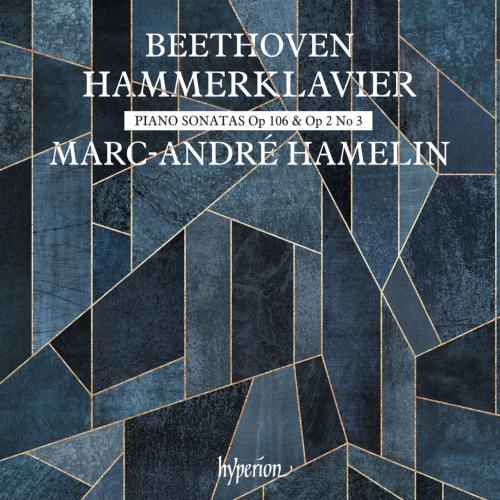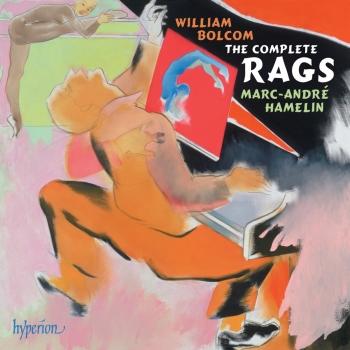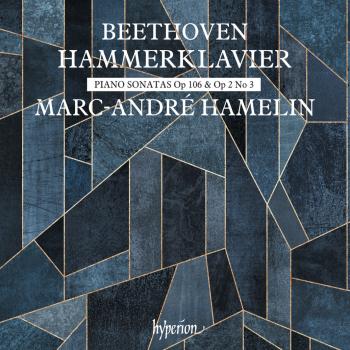
Beethoven: Piano Sonatas, Op. 2/3 & 106 Marc-André Hamelin
Album info
Album-Release:
2024
HRA-Release:
04.10.2024
Label: Hyperion
Genre: Classical
Subgenre: Instrumental
Artist: Marc-André Hamelin
Composer: Ludwig van Beethoven (1770-1827)
Album including Album cover Booklet (PDF)
I`m sorry!
Dear HIGHRESAUDIO Visitor,
due to territorial constraints and also different releases dates in each country you currently can`t purchase this album. We are updating our release dates twice a week. So, please feel free to check from time-to-time, if the album is available for your country.
We suggest, that you bookmark the album and use our Short List function.
Thank you for your understanding and patience.
Yours sincerely, HIGHRESAUDIO
- Ludwig van Beethoven (1770 - 1827): Piano Sonata No. 29 in B-Flat Major, Op. 106 "Hammerklavier":
- 1 van Beethoven: Piano Sonata No. 29 in B-Flat Major, Op. 106 "Hammerklavier": I. Allegro 10:56
- 2 van Beethoven: Piano Sonata No. 29 in B-Flat Major, Op. 106 "Hammerklavier": II. Scherzo. Assai vivace – Presto 03:00
- 3 van Beethoven: Piano Sonata No. 29 in B-Flat Major, Op. 106 "Hammerklavier": III. Adagio sostenuto, appassionato e con molto sentimento 18:40
- 4 van Beethoven: Piano Sonata No. 29 in B-Flat Major, Op. 106 "Hammerklavier": IV. Largo – Allegro – Allegro risoluto 12:13
- Piano Sonata No. 3 in C Major, Op. 2 No. 3:
- 5 van Beethoven: Piano Sonata No. 3 in C Major, Op. 2 No. 3: I. Allegro con brio 07:49
- 6 van Beethoven: Piano Sonata No. 3 in C Major, Op. 2 No. 3: II. Adagio 07:18
- 7 van Beethoven: Piano Sonata No. 3 in C Major, Op. 2 No. 3: III. Scherzo. Allegro 03:25
- 8 van Beethoven: Piano Sonata No. 3 in C Major, Op. 2 No. 3: IV. Allegro assai 05:34
Info for Beethoven: Piano Sonatas, Op. 2/3 & 106
The transcendental difficulties of Beethoven’s ‘Hammerklavier’ sonata will always deter all but the greatest pianists of the day, with only a select few able to master its formidable musical, emotional and technical challenges. Marc-André Hamelin is of course very much of their number, and his performance—one which relishes all the work’s glory and grandeur—is simply stupendous.
The ‘Hammerklavier’ sonata is by far Beethoven’s longest piano sonata, and in his view it was also his finest. It was begun in or just before December 1817, after a fallow period of over a year in which he had composed next to nothing, hindered by the after-effects of an infection in October the previous year, according to his own account. He seems to have intended from the outset to dedicate the sonata to Archduke Rudolph of Austria (1788-1831), who had been his pupil, friend, patron and chief supporter for nearly ten years. Its nickname derives from Beethoven’s search for a German word for the piano. The word used today, ‘Klavier’, could in those days mean either piano or harpsichord, and so after asking for advice he decided on ‘Hammerklavier’ for the instrument. He then used this term in his preceding sonata (Op 101 in A major), the present one, and the one after (Op 109 in E major). These other two sonatas, however, begin gently, whereas the hammer-like blows at the start of Op 106 suggest ‘Hammerklavier’ as an appropriate nickname. It was issued as a ‘grand sonata’, a term reserved by Beethoven for large-scale sonatas written and published separately.
Composition of the sonata took longer than usual, partly because of its great size and complexity, and partly because Beethoven was still not back to full health. As with all his major works, he made numerous sketches and rough drafts in the course of composing the sonata, but unfortunately a large number of them are lost, including a complete sketchbook (the so-called ‘Boldrini’ sketchbook) that was described by Gustav Nottebohm before disappearing around 1890. Beethoven claimed that the first two movements of the sonata had been completed in time for Rudolph’s name-day in 1818 (17 April), and the sketches seem to bear this out, although he made adjustments at a later date. The remaining two movements were completed later in 1818, but were evidently ready by about the end of the year. ...
Marc-André Hamelin, piano
No biography found.
Booklet for Beethoven: Piano Sonatas, Op. 2/3 & 106













